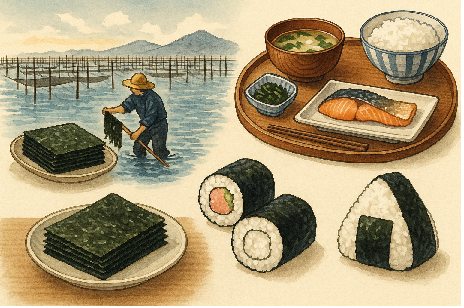
For many Japanese people, nori (seaweed) is more than just a wrap for sushi—it’s a daily staple, a familiar companion to steaming bowls of rice, and a small but essential part of the traditional Japanese breakfast. Paper-thin, jet black, and crisp when dry, nori has quietly anchored itself in the fabric of Japan’s food culture for centuries.
More Than Just a Sushi Wrapper
Around the world, nori is most often associated with sushi rolls, and in recent years, that image has traveled far and wide. But in Japan, nori plays a much broader role. It’s commonly served alongside breakfast rice, enjoyed with soy sauce, and used to wrap onigiri (rice balls)—a comfort food beloved by children and adults alike. The subtle umami flavor of roasted nori enhances the taste of rice while bringing the scent of the ocean to the table.
The Prestige of Ariake Sea Nori
Among Japan’s many nori-producing regions, the Ariake Sea in Kyushu is regarded as a premier source. With its unique tides, shallow waters, and nutrient-rich environment, the Ariake Sea produces nori of exceptional quality—known for its smooth texture, deep flavor, and melt-in-the-mouth delicacy. Chefs and home cooks alike seek out “Ariake Nori” for its superior characteristics.
A Craft Bound by Nature
The cultivation of nori is no easy feat. It’s a labor-intensive process deeply connected to the natural rhythms of the sea. Farmers must carefully tend to seaweed nets submerged in chilly waters, monitor weather conditions, and harvest at precisely the right time. Any shift in temperature, tides, or water quality can greatly affect the yield.
In recent years, the production of nori has faced challenges. Climate change, shifting sea temperatures, and rising costs have led to decreased harvests and concern among producers. Yet, the tradition continues—sustained by the dedication of communities that have cultivated nori for generations.
From Local Tables to Global Palates
Thanks to the worldwide popularity of sushi, nori is now a globally recognized ingredient. Even onigiri, once a niche snack, is gaining attention in places like the U.S., U.K., and parts of Southeast Asia. As the world gets a taste of these Japanese staples, it’s also a great moment to appreciate where this humble seaweed comes from—and the people who produce it.
Why not explore the real thing? Authentic Ariake nori is available through online platforms like Amazon or Rakuten, and trying it may just change the way you see this thin, black sheet of seaweed. Crisp it slightly over a flame, wrap it around freshly steamed rice, and taste a piece of Japan’s ocean heritage.
海の味:有明海産の海苔と日本料理の魂
多くの日本人にとって、海苔は単なる寿司を巻くためのものではありません――それは日々の主食の一部であり、湯気を立てるご飯にそっと寄り添う、伝統的な朝食に欠かせない小さくも本質的な存在です。紙のように薄く、漆黒で、乾燥してパリッとした海苔は、何世紀にもわたり静かに日本の食文化に根を張ってきました。
寿司のラッパー以上の存在
世界中では、海苔といえば寿司ロールを思い浮かべる人が多いですが、日本ではもっと広く活躍しています。朝食のご飯に添えられ、しょうゆと一緒に楽しみ、おにぎり(お米を握ったもの)を包むためにもよく使われます――子供から大人までに愛される心のこもった食べ物です。焼き海苔のほのかなうま味はご飯の味を引き立て、食卓に海の香りをもたらします。
有明海産の海苔の誇り
日本にはたくさんの海苔の産地がありますが、その中でも九州の有明海は最高級の産地として知られています。独特の潮の満ち引き、浅瀬、栄養豊富な環境を持つ有明海では、非常に質の高い海苔が育ちます――なめらかな食感、深い風味、そして口の中でとろけるような繊細さが特徴です。料理人も家庭の料理好きも「有明海苔」をその品質の高さで選びます。
自然に左右される職人の仕事
海苔の栽培は簡単な仕事ではありません。それは海の自然なリズムと深く結びついた、労力を要する作業です。海の冷たい水の中に沈められた網を丁寧に世話し、天候を見守り、まさに最適なタイミングで収穫する必要があります。気温や潮の流れ、水質のわずかな変化も収穫量に大きく影響します。
近年では、海苔の生産はさまざまな課題に直面しています。気候変動や海水温の変化、コストの増加などにより、収穫量が減少し、生産者の間で懸念が高まっています。それでも、海苔作りの伝統は続いています――代々この文化を支えてきた地域の人々の情熱によって。
地元の食卓から世界の味覚へ
寿司の世界的な人気のおかげで、海苔はいまや世界で知られる食材となりました。かつては限られた人たちだけが知っていたおにぎりも、アメリカやイギリス、東南アジアの一部などで注目されるようになっています。こうして世界中の人々が日本の定番を味わうようになる今こそ、この控えめな海藻がどこから来るのか――そしてそれを育てる人々について、思いをはせる良い機会かもしれません。
本場の海苔を試してみるのもおすすめです。有明海苔はAmazonや楽天などのオンラインショップでも手に入れることができます。そのままでも、軽く火であぶっても、ご飯を巻いても、日本の海の恵みを感じるひとときが味わえるはずです。
